Family Orchidaceae Scientific name Leptotes Rank Genus | Higher classification Laeliinae | |
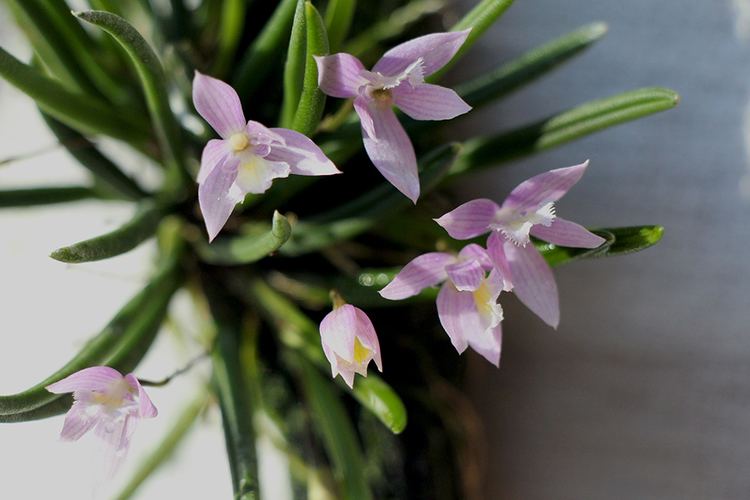 | ||
Similar | ||
Leptotes, abbreviated Lpt in horticultural trade, is a genus of orchids formed by nine small species that grow in the dry jungles of south and southeast Brazil, and also in Paraguay or Argentina. They are small epiphytic plants of caespitose growth that sometimes resemble little Brassavola, as they share the same type of thin terete leaves, though they are more closely related to Loefgrenianthus.
Contents
Some species of Leptotes are widely cultivated and form showy displays when completely in bloom although they are not among the easiest to grow. The majority of the species are not cultivated and some are so rare to be almost unknown; five of the nine species have been described since 2000. Besides being cultivated for their ornamental value, there are records of the flowers and fruits of Leptotes bicolor being used as a substitute for vanilla in milk, ice cream, tea and candies.
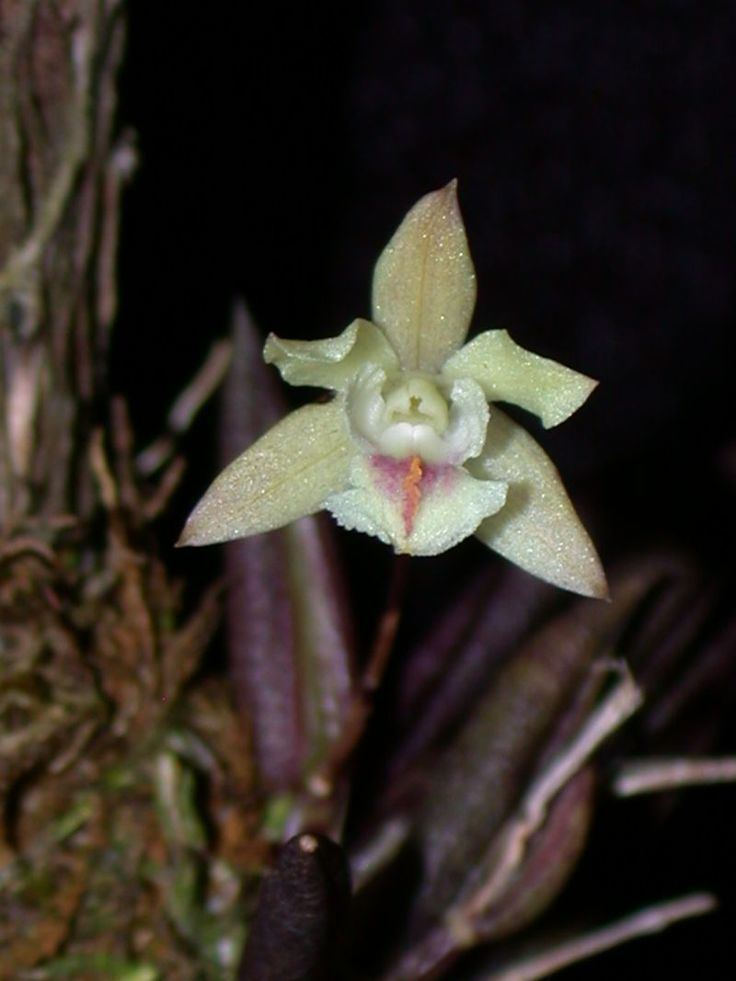
Distribution

The species of Leptotes were originally discovered in the Atlantic Forest of Brazil and are always seen living epiphytically. Two species have since been found in other countries, L. unicolor in Argentina, and L. bicolor in Paraguay. Three species show a high degree of endemism in the south of Bahia State. The states of southeastern Brazil can be considered the center of its distribution since they host the highest number of species and the Leptotes are most abundant there, however, the range is from the Serra da Jibóia chain of mountains, in Bahia, to the North of Rio Grande do Sul state.
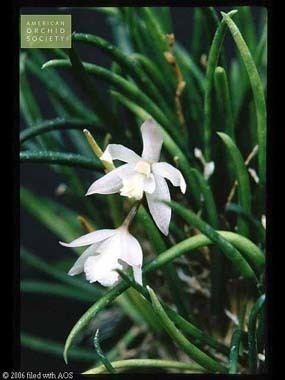
The species in the group that are characterized by wide open flowers, such as Leptotes tenuis and L. pauloensis, are more frequently found in montane cloud forests. L. bicolor has the broadest range and can survive in both the cloud forests and the dryer woods on the plateaus of the Serra do Mar chain of mountains. Leptotes unicolor grows optimally in cooler areas, above 700 meters of altitude, and is frequently found growing on Araucaria and Podocarpus trees in the southern areas of Brazil.
Description
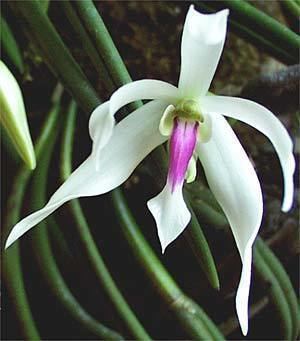
Species assigned to the genus Leptotes have a short cylindrical rhizome. They have small pseudobulbs that almost imperceptibly prolongate in one, rarely two, terete fleshy leaves. They have variable characteristics and can be short or long, erect or hanging, dark green or purple, and often have a wrinkly surface and a deeper ridge in the face. The inflorescence is apical, generally short, and grows from the apex of the pseudobulb without a protecting spathe and bears up to seven flowers, although fewer are more common. The flowers are relatively large when compared to the overall plant dimensions, normally partially bent and in some species forming groups with a very showy aspect. They are fragrant and this perfume can last from ten to twenty days.
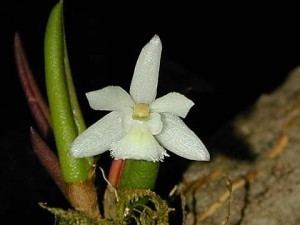
The appearance of the petals and sepals is similar, both are elongated although the petals are slightly more narrow. Flower colors are generally greenish, white or variable shades of pink and the labellum (a special petal attractive to pollinators) can be spotted in pale yellow, light purple or lilac. The labellum is located along the column and trilobed (three lobes). The lateral lobes are small and raised beside the column, although never involving it. The intermediate lobe is much bigger and quite variable between species. They can have either lanceolate or obovate shape, occasionally be fleshy, flat or bending backwards; in some species they have denticulated edges but are smooth in others. Rarely, calli are present, with claws holding them attached to the sides of the column. The column is short, thick and erect, normally greenish, biauriculated, and bears six pollinia of different sizes, two larger in the center and four smaller in two pairs held by a short caudicle in an arrangement that is unique among orchids. Their fruits are rounded, succulent and have a perfume reminiscent of vanilla.
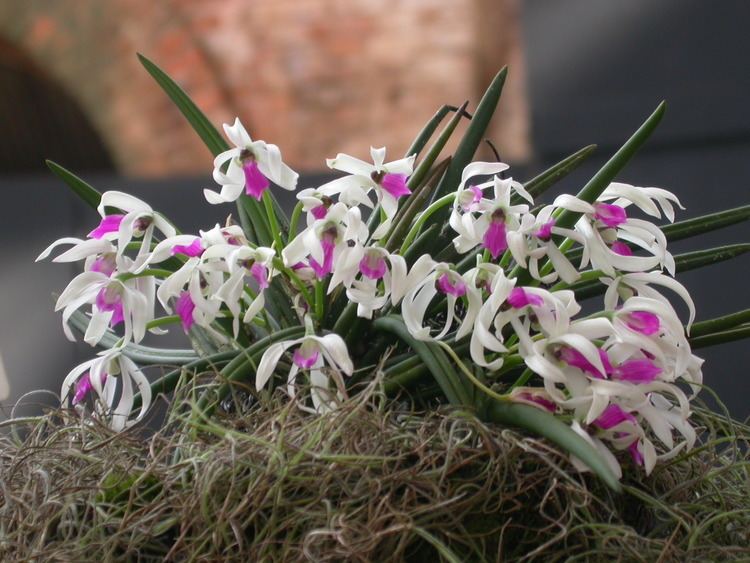
The agent for the pollination of Leptotes has never been observed. Cássio van den Berg postulates, judging from the colors and morphology of the flowers, that bees are the primary agent, while other orchidologists suspect pollination by hummingbirds is more important.
As the roots of Leptotes rot easily with excessive humidity, the best results for their culture are achieved when they are mounted on plaques of vegetal fiber or tree cork. Watering and fertilizer must be more frequent during active growth periods and less during dormant periods. Ideal growth conditions require an intermediate temperature and exposure to filtered sunlight.
Species
The three main characteristics that differentiate between the species of Leptotes are the general proportions of the leaves, the shape of the flowers, and the way the flowers open. From these, the species can be classified into two main groups.
One group is formed by the four species with flowers of elongated segments, which generally are not widely open. These species present malleable inflorescences that leave the flowers slightly or very overthrown, frequently facing down. Almost all the species of this group have long leaves, of comparatively lighter tones, generally with smooth surfaces, that are longer than the inflorescences.
The other group is formed by five smaller species that have more rounded flowers with petals and sepals that are wide open and flatter. The leaves are shorter wrinkly leaves, generally very dark green or purple colored. The species of this group often have only one or two flowers on each inflorescence. Four of them are very similar and sometimes difficult to distinguish.
